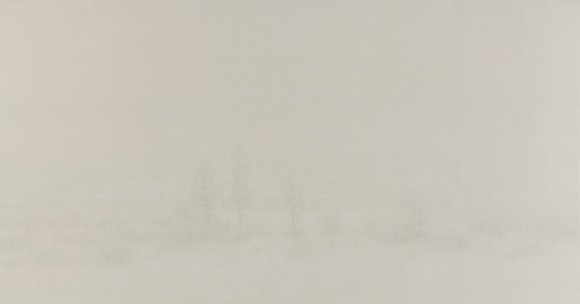
Qiu Shihua, Untitled, 2011; Oil on canvas, 150x286cm
Galerie Urs Meile announces the opening of the new exhibition space in the 798 Art District in Beijing with an inaugural exhibition by Qiu Shihua. The new gallery is located in one of the historical buildings that once made up the Dashanzi factory complex and is now known as the 798 Art District. In recent months the former warehouse has been completely renovated under the direction of the Japanese architect Mitsunori Sano. The 520-square-meter floor plan now contains generous-sized exhibition and reception areas, offices, and storage rooms. Offering perfect conditions for exhibitions featuring its rich and diverse roster of artists, the new venue underlines Galerie Urs Meile’s commitment to the city’s vibrant art scene.
Qiu Shihua (*1940 in Zizhong, Sichuan Province, China; lives and works in Shenzhen and Beijing, China) holds a singular position within contemporary art. At first glance you see big, off-white, seemingly empty canvases. But at second glance, actual landscapes appear. Terrain forms out of the white background and vanishes again. Upon closer inspection you realize that the apparently white surfaces are surprisingly colorful and that traces of thinly applied pigment are visible.
Established contemporary art terms don’t help to describe what a viewer experiences in front of Qiu Shihua’s paintings. Oft-quoted modes of perception, ideas of space, landscape, or painting itself are not of concern to the artist. You have to deploy a spiritual vocabulary to find words for Qiu Shihua’s art: as a viewer, it is best to let associations come and go, similar to the way that thoughts appear and disappear during meditation, and to give up on reason, will, and intention in favor of an intuitive, acquiescent perception. Visualization and imagination are also helpful concepts for approaching Qiu Shihua’s works. His images are projection screens. Self-confidently, the artist states that he is not interested in other peoples’ thoughts, and this could be interpreted as an aloof attitude. But it is not so much a lack of interest in communication than it is the insight that, where spirituality is concerned, a profound exchange is simply not possible. Goethe’s words can be applied to every image, but they are particularly true of Qiu Shihua’s blank spaces: “You only see what you already know and understand.” The artist allows his audience many liberties. Whatever anyone sees in the painting is in the painting, he states. His motifs are proposals. Because of this his landscapes are archetypes and not copies of existing scenery. Chinese art has a long tradition of idealized landscapes. In Western art history the first landscape painting dates back to the early Renaissance, and to this day they are mainly concerned with representation. Not only did China have a head start of roughly a thousand years—the first landscape paintings date from the Tang Dynasty (618-907)—but Chinese art also has a fundamentally different notion of the landscape: from the beginning landscape was conceived as an idealized, almost ornamentally organized space for meditation. A tradition Qiu Shihua relates to.
For Qiu Shihua, the development of his radical, achromatic style was an act of liberation from the logic of the Western avant-garde and his education in Socialist Realism’s painting styles. Trained at the art academy in Xi’an, he initially worked as poster painter for a theater in Tongchuan. During the 1980s he had the opportunity to travel to Europe and to study Western art history. He has been painting his characteristic, neutral landscapes since the early 1990s.
About the exhibition
Dates: May 20 - August 6, 2017
Opening: Saturday, May 20, 2017; 5 - 7pm
Venue: Galerie Urs Meile
Courtesy of the artist and Galerie Urs Meile.




























